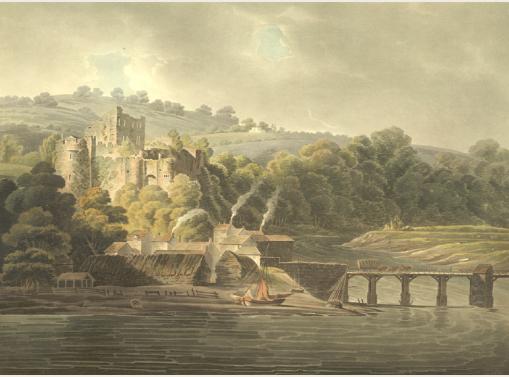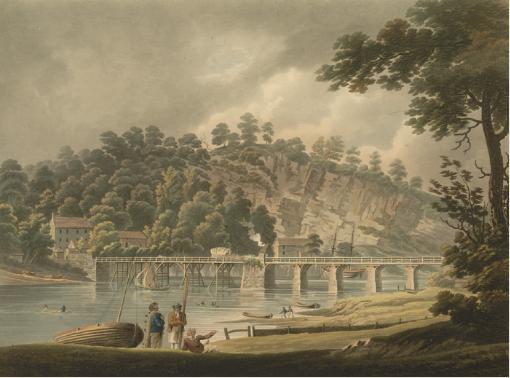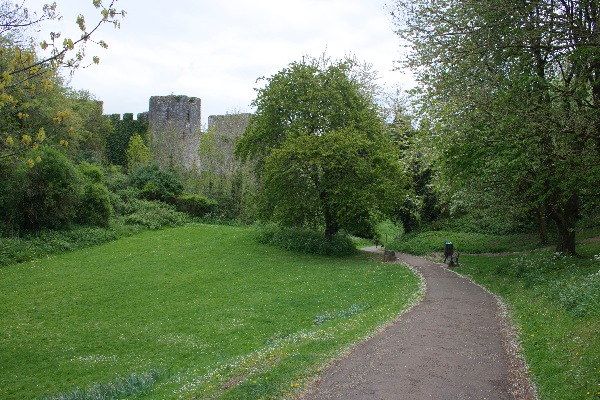
Chepstow
(A description written in 1891)
A Market Town, head of a Petty Sessional division, Union and County Court district; and a Parish with a first-class station on the Great Western railway, South Wales branch; 141.1/4 miles from London, 16 south-by-east from Monmouth, 17 east from Newport and 28 south-west from Gloucester, in the Southern division of the county, Hundred of Caldicot, eastern division of Netherwent rural deanery, Monmouth archdeaconry and Llandaff diocese.
 It stands on the side of a hill which rises abruptly from the bank of the river Wye, near its confluence with the Severn. The tides here are peculiar and rise as high as 50 feet. Over the river Wye, which separates the Counties of Monmouth and Gloucester, is a cast-iron bridge, erected in 1816 upon the site of an ancient structure of wood and stone; and a railway bridge designed by I.K. Brunel Esq.
It stands on the side of a hill which rises abruptly from the bank of the river Wye, near its confluence with the Severn. The tides here are peculiar and rise as high as 50 feet. Over the river Wye, which separates the Counties of Monmouth and Gloucester, is a cast-iron bridge, erected in 1816 upon the site of an ancient structure of wood and stone; and a railway bridge designed by I.K. Brunel Esq.
Not long before the dissolution of the Marches, Charles, first Earl of Worcester, in his capacity as Lord Marcher, granted a new Charter of incorporation to the bailiffs and burgesses of his town of Chepstow, which is then described as having "fallen into great ruin, indulgence and decay." The Charter was dated December 2nd, 1524, and seems to have been acted upon down to the time of Charles II, when its final extinction was due to some dispute between the Duke of Beaufort and the burgesses, owing to which no bailiffs were appointed and the corporation ceased to exist. The principal officers were the steward of the lord, two bailiffs chosen by the burgesses and two sergeants-at-mace.
The town, or "port walls" as they are commonly called, are still perfect, except where broken through by the South Wales railway, and extend for about half-a-mile from the banks of the Wye at the southern extremity of the town, along the back of the George Hotel, terminating opposite to the western entrance of the castle, and inclosing an area upwards of ninety acres.
The walls were defended at irregular intervals by ten round towers, all of which remain, and the entrance to the town was through a large gate houses, still standing, which was given to the bailiffs by the charter of 1524 to be used as the town gaol. The town, formerly incorporated, is now under the jurisdiction of a local board of 12 members, formed in 1864, and is paved, lighted with gas by a company formed in 1857, and supplied with water from works at Chepstow Park and St Arvans Grange, the property of the company; the reservoirs have a combined capacity of 2,900,000 gallons.
Chepstow is now a Port under the Customs, but is attached to Lydney, which is a creek in the port of Gloucester.
The police control is entrusted to the county constabulary, who have officers and a police station here.
 The church of St. Mary, supposed to date from the 11th century, is an ancient structure of stone in the Norman style (which is now about to be restored and improved), consisting of chancel, nave, transepts and an embattled western tower, containing 8 bells and clock with chimes; nothing now remains of the old tower, which was central, the present having been erected in 1705-6; the principal entrance is through a fine Norman archway beneath the tower; the whole fabric underwent considerable alterations in 1841, when a chancel and transepts were added: it is much to be regretted that these alterations were of such a nature as to entirely destroy the original character of the building; the alterations now in progress will, however, bring it back to its former state; the floor is to be lowered to its ancient level and the arch between the tower and nave reopened. Monuments: Henry, Second Earl of Worcester d.1549; Margaret Clayton and her two husbands; floor-stone engraved to Henry Marten who was imprisoned and died in Chepstow castle in 1680. This church original formed part of the Benedictine Priory of Striguil, or Chepstow, which was founded about the time of Henry I, by one of the Norman lords of Chepstow and attached to the Abbey of Cormeilles in Normandy: at the Dissolution the annual revenue of this monastery amounted to £32 3s. 4d: the church has 1,183 sittings. The register dates from the year 1596, and contains a number of entries relating to the siege of the castle during the civil wars. The living is a vicarage, tithe rent-charge £124, net yearly value £220 and residence, in the gift of Simeon's Trustees, and held since 1888 by the Rev. Egerton John Hensley M.A. of Exeter College, Oxford.
The church of St. Mary, supposed to date from the 11th century, is an ancient structure of stone in the Norman style (which is now about to be restored and improved), consisting of chancel, nave, transepts and an embattled western tower, containing 8 bells and clock with chimes; nothing now remains of the old tower, which was central, the present having been erected in 1705-6; the principal entrance is through a fine Norman archway beneath the tower; the whole fabric underwent considerable alterations in 1841, when a chancel and transepts were added: it is much to be regretted that these alterations were of such a nature as to entirely destroy the original character of the building; the alterations now in progress will, however, bring it back to its former state; the floor is to be lowered to its ancient level and the arch between the tower and nave reopened. Monuments: Henry, Second Earl of Worcester d.1549; Margaret Clayton and her two husbands; floor-stone engraved to Henry Marten who was imprisoned and died in Chepstow castle in 1680. This church original formed part of the Benedictine Priory of Striguil, or Chepstow, which was founded about the time of Henry I, by one of the Norman lords of Chepstow and attached to the Abbey of Cormeilles in Normandy: at the Dissolution the annual revenue of this monastery amounted to £32 3s. 4d: the church has 1,183 sittings. The register dates from the year 1596, and contains a number of entries relating to the siege of the castle during the civil wars. The living is a vicarage, tithe rent-charge £124, net yearly value £220 and residence, in the gift of Simeon's Trustees, and held since 1888 by the Rev. Egerton John Hensley M.A. of Exeter College, Oxford.
Besides the Priory church there were formerly several ancient chapels. That of St. Ewen, in Bridge street, is still standing, but has been modernised and converted into dwelling houses. Lower down in Bridge street was the chapel of St Anne, some vestiges of which yet remain; and on the opposite side of the bridge stood the chantry chapel of St David. In Beaufort square is a room with an ancient groined roof, now used as a post office, which is said to have been the crypt of another chapel, and there was also a chapel, dedicated to St.Thomas, in Welsh street.
The Catholic Chapel, Welsh street, dedicated to St. Mary is an edifice of stone in the Gothic style, erected in 1827 and seats about 200 persons. Rev. John Baptist Quaid, priest.
The Baptist chapel, Lower Church Street, is a plain stone building, erected in 1818 and enlarged in 1869 and has 300 sittings. Rev. A J Davies, minister.
The Bible Christian chapel, Moor Street, was erected in 1877, and has 150 sittings. Rev. John Rawlings, minister.
The Congregational chapel, Welsh Street, is a building of stone, erected in 1824, and will seat 450 persons. Rev. James Hale Stephens, minister.
The Wesleyan chapel, Albion Square, also in the Gothic style, was erected in 1855 at a cost of £1,260; it seats 250 persons. Rev. Joseph Lister, minister.
The Catholic Apostolic church, Hawker Hill Street, is an edifice of stone in a Classic style and was erected in 1832 and has 300 sittings.
The Cemetery, at Hardwick, formed in 1856 at a cost of about £2,300, has two mortuary chapels and is under the control of the local Board, acting as a burial ground.
The Public buildings comprise the Bank Buildings, erected by the late John Best Snead Esq, banker; the Assembly Rooms, forming part of the Beaufort Arms hotel; the Market Hall, Nelson Street, built by the Duke of Beaufort.
Here is the A Company of the 2nd Volunteer Battalion South Wales Borderers, and the head quarters of the F Troop of the Royal Gloucestershire Hussar Yeomanry Cavalry.
The local Farmers' Club holds its meetings at the George Hotel, a ploughing match in connection therewith takes place annually when a considerable sum is awarded in prizes. The Freemasons' Hall is in Nelson street. There is a County Club with reading and billiard rooms in Beaufort square. The Conservative Working Men's Club, Welsh street, was established in 1884, and consists of a reading and amusement rooms. Steeplechases are held annually on a course adjacent to the town, the office being at the George Hotel; the Cyclists' Touring Club have their head quarters at the same hotel. The Fire Brigade, established 1889, consists of a captain and 9 men; the engine station is in Oxford Street. The Chepstow Landing Stages Co. Limited was formed in 1889 for facilitating the landing of passengers brought by water to the town.
There are two Almshouses, one of which in Upper Church Street is for ten persons, five men and five women, and is supported from estates in Northamptonshire, bequeathed by Sir Walter Montague, of Pencoyd Castle, in 1614, and now owned by the Duke of Buccleuch, who pays £33 yearly to this charity; the other is in Bridge street, erected and endowed by funds bequeathed by Thomas Powis, of Enfield, in the county of Middlesex, vintner (a native of this place), in 1716, is for twelve persons, six men and six women; and other charities producing about £200 are distributed yearly.
The trade of the town consists chiefly in grain, timber, bark, coal and building stone. Here is ship-building and engineering establishment carried on by Messrs E Finch & Co. Limited, which gives employment to a large number of hands; a quarry, a corn mill, a bobbin reel factory, several malting establishments, two brick fields, several wharves, some boat-building yards, and branches of the London and Provincial Bank Limited and the National Bank of Wales Limited.
The Chepstow Fishery, celebrated for the salmon caught in the rivers Wye & Severn is strictly preserved and is held under the Duke of Beaufort by Messrs Miller Bros.
Schools:
Board School, Station Road, erected as a National school in 1827, for 300 boys; average attendance, 200; William Howe, master; A E Opie, assistant master; Miss E J Woods, assistant mistress
Board School, Bridge Street (girls), built in 1878 for 142 children; average attendance 86; Miss E A Griffiths, mistress
Board School, Bridge Street (infants), built in 1878, for 130 children; average attendance, 90; Miss Minnie Jones, mistress
Church School, Nelson Street, (girls & infants), erected in 1855, for 185 children; average attendance, 65 girls & 72 infants; Miss Alice Welsford, girls' mistress; Miss Annie Moulder, infants' mistress
Catholic School, Welsh Street, (for boys and girls), erected about 1859, for 40 children; average attendance, 30; Miss Ellen Richardson, mistress
Post, M.O. & T.O., S.B. & Annuity & Insurance Office, Beaufort Square: Postmaster, W T Preddy. Open 7 a.m. to 9 p.m.; Sundays 7 to 10 a.m.
Newspaper: Chepstow Weekly Advertiser, William Edward Clark, printer & publisher; published Friday evening; 16 High Street.
Railway station: Great Western, Llewellyn Bradshaw, station master
Conveyance: A four-horse coach leaves the railway station daily during the summer for Wyndcliff & Tintern Abbey. Omnibuses & private carriages from the Beaufort Arms & George hotels meet all the railway trains.
Carriers by Water:
Chepstow Boat, weekly to Bristol, from the Quay; Henry Gillam, proprietor
The Market day is Saturday, and there is a market held fortnightly, when farming stock is offered for sale. The Fairs are held on the market day nearest March 1st and the market day nearest the Friday in Whitsun week. The principal Fairs are the Wool and Pleasure Fair on June 22nd and those on the Tuesday nearest to August 1st (for horses) and the Friday before October 29th.
Hardwick House, the residence of Ernest Hartland Esq. M.A., J.P. the principal seat in the parish, is very beautifully situated upon a wooded eminence on the banks of the Wye: this was formerly the residence of Dr. Coplestone, Bishop of Llandaff. Beyond the mansion, at a place called "The Bulwarks," are the remains of an extensive British camp; it occupies an area of about three acres. Thornwell, situated near the confluence of the Wye and Severn, now a farm-house, was formerly the residence of the Morgan family.
The Duke of Beaufort K.G. is lord of the manor and principal landowner; the area is 1,095 acres of land and 187 of tidal water and foreshore; rateable value, £14,412.
The population in 1881 was 3,591, of the parish 3,566, including 4 officers and 161 inmates in the workhouse
Chepstow engravings c.1802 courtesy of & © The British Library
(extracts from Kelly's 1891 Directory of Monmouthshire, transcribed by J. Doe)


Aberbargoed • Aberbeeg • Abercarn • Abergavenny • Abersychan • Abertillery (also see Aberystruth) • Aberystruth • Basseleg • Bettws (near Llantillio Pertholey) • Bettws (near Newport) • Bettws Newydd • Bishton • Blackwood • Blaenavon • Blaina • Briery Hill • Bryngwyn • Bwlch Trewyn • Caerleon or Llangattock-Juxta-Caerleon (see Christchurch for Caerleon Village) • Caerwent • Caldicot • Castleton • Cefnycrib • Chapel Hill • Chepstow • Christchurch (also see Newport) • Clawrplwyf • Coedkernew • Coed y Paen • Crick • Croesyceiliog • Cross Ash • Cross Keys • Crosshands • Crumlin (also see Llanhilleth & Mynyddislwyn) • Cwm (also see Ebbw Vale) • Cwmavon (also see Trevethin) • Cwmbran (also see Llanvihangel Llantarnam & Llanfrechfa) • Cwmcarn • Cwmcarvan • Cwmffrwdoer • Cwmnantddu • Cwmtillery (also see Aberystruth) • Cwmynyscoy • Cwmyoy • Devauden • Dewstow • Dingestow • Dinham • Dixton Newton • Duffryn • Earlswood • Ebbw Vale • Fleur-de-Lys • Freehold • Garndiffaith (also see Trevethin) • Garndyrris • Garnfach • Gellygroes • Glascoed • Goldcliff • Golynos • Govilon • Goytre • Graig • Griffithstown (also see Llanfrechfa & Panteg) • Grosmont • Gwehelog • Gwernesney • Hardwick • Henllys • High Cross • Highmoor Hill • Howick • Ifton • Itton • Kemeys Commander • Kemeys Inferior • Kilgwrrwg • Langstone • Little Mill • Llanarth • Llanbadoc • Llanbedr • Llandavenny • Llandewi Fach • Llanddewi Rhydderch • Llanddewi Skirrid • Llandegveth • Llandenny • Llandevaud • Llandogo • Llanellen • Llanfaeneor • Llanfair Discoed • Llanfair Gilgoed • Llanfair Kilgeddin • Llanfihangel Crucorney • Llanfihangel Gobion • Llanfihangel juxta Roggiett • Llanfihangel Llantarnam • Llanfihangel nigh Usk • Llanfihangel Pont y Moile • Llanfihangel Tafernbach • Llanfihangel Tor y Mynydd • Llanfihangel Ystern Llewern • Llanfihangel y Vedw • Llanfoist • Llanfrechfa • Llangattock • Lingoed • Llangattock nigh Usk • Llangattock Vibon Avel • Llangeview • Llangibby • Llangoven • Llangua • Llangwm Ishaf & Llangwm Uchaf • Llanhennock • Llanhilleth • Llanishen • Llanllowell • Llanmartin • Llanover • Llanrumney • Llansantffraed • Llansoy • Llanthewy Rytherch • Llanthewy Skirrid • Llanthewy Vach • Llanthomas • Llanthony • Llantillio Crossenny • Llantillio Pertholey • Llantrissent • Llanvaches • Llanvair Discoed • Llanvair Kilgeddin • Llanvapley • Llanvetherine • Llanwenarth Citra • Llanwenarth Ultra • Llanwern • Lliswerry • Llwyndu • Machen (Upper & Lower) • Maes-y-cwmmer • Magor • Maindee (also see Christchurch & Newport) • Malpas • Mamhilad • Marshfield • Mathern (also see St Pierre) • May Hill • Michaelston y Fedw • Mitchel Troy • Monkswood • Monmouth • Mounton • Mynyddbach • Mynyddislwyn • Mynyddmaen • Nantyderry • Nantyglo • Nash • New Town • New Tredegar • Newbridge • Newcastle • Newchurch East & West • Newport • Nightingale Village • Oldcastle • Overmonnow • Panteg • Par Grace Dieu • Pen y Clawdd • Penalt • Penbiddle • Pengam • Penhow • Penmaen • Penpergwm • Penrhos • Penrose • Penterry • Pentrepeod • Penygarn • Penyrheol • Peterstone Wentloog • Pillgwenlly • Ponthir • Pontllanfraith • Pontnewydd (also see Llanfrechfa) • Pontnewynydd • Pontrhydyryn • Pontygof • Pontymister • Pontymoile • Pontypool • Pontywain • Porthcasseg • Portskewett • Pwll Du • Pwllmeyric • Raglan • Redbrook • Redwick • Rhydgwern • Rhymney • Risca • Rock • Rockfield • Rogerstone • Roggiett • Rumney • Runston (also see Mathern) • St Arvans • St Brides Netherwent • St Brides Wentloog • St Kingsmark • St Lawrence • St Maughans • St Mellons • St Pierre (also see Mathern) • St Woolos • Sebastopol (also see Panteg) • Shirenewton • Sirhowy • Six Bells • Skenfrith • Snatchwood • Somerton Common • Sudbrook • Talywain (also see Trevethin) • The Race and Upper Race • Tintern Abbey • Tintern Parva • Tranch • Tredegar • Tredunnock • Tregare • Trellech • Trellech Grange • Trevethin • Treworgan • Trostrey • Undy • Upper Machen • Usk • Varteg • Victoria • Waunlwyd • Whitebrook • Whitson • Wilcrick • Wolvesnewton • Wonastow • Wyesham • Ynysddu
All images unless otherwise credited are © MonGenes and may not be reproduced without permission
© MonGenes 2017


 Flag of St David
Flag of St David


























